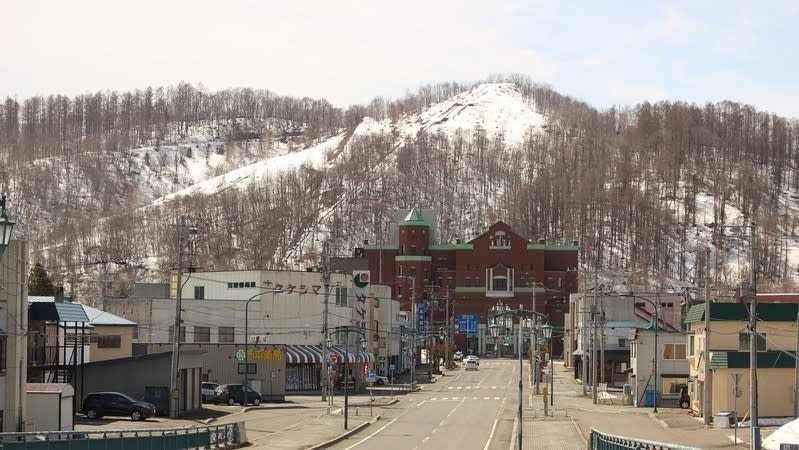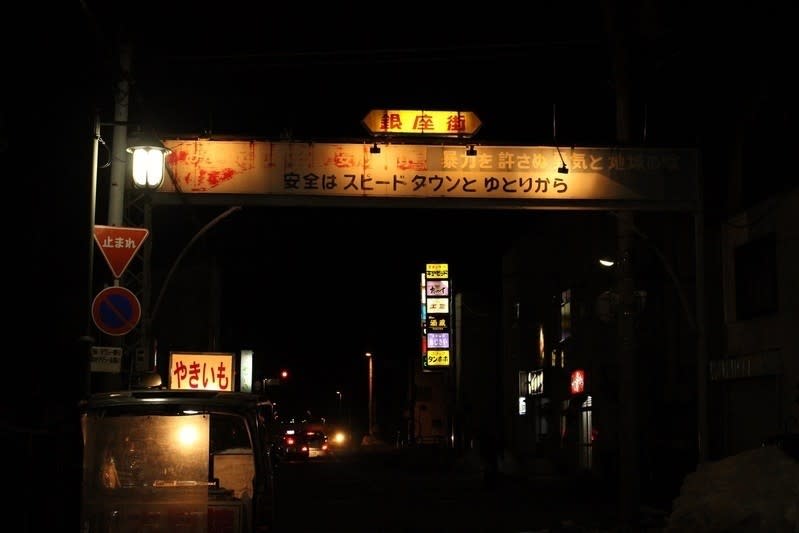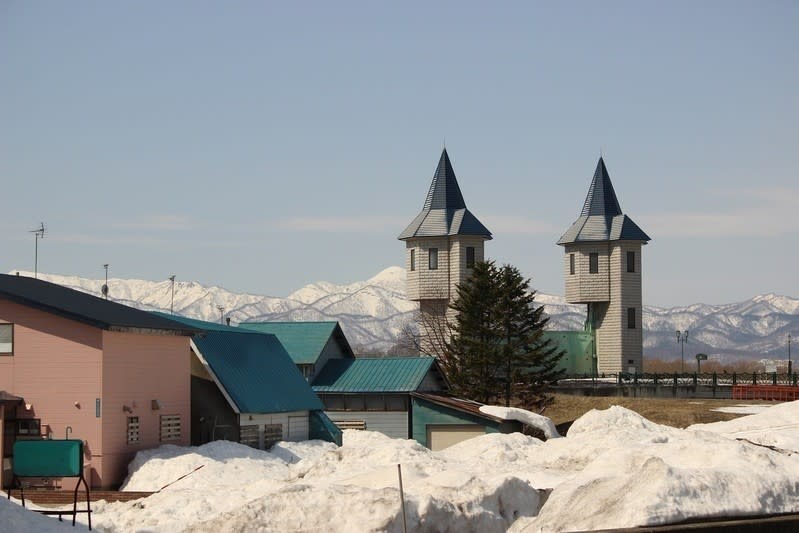Asking about nuclear power plants in a city of coal mines
Cavelnaria Yoshida | Travel writer
The original Japanese article was published on 16:58 May 26, 2016

The pile of coal waste towering in the background of downtown Akabira, a former coal town in Hokkaido/Photo taken by the author
Should we have preserved the coal mines?
Utashinai is a city located in Hokkaido that has Japan’s smallest population. The city flourished as a coal town, but the population dwindled with the closing of the coal mines. During its peak the city was home to over 40,000 people, but today that number has decreased to 3,000 and some. The city was modeled to look like a Swiss town, but it has definitely lost its liveliness over the years.
During the early 1960s (late Showa 30s), when the country switched its main energy source from coal to oil, the coal mines were forced to close down. Losing their main industry, the city’s population decreased drastically. However, together with the oil shock, Japan’s dependency on nuclear power continued to increase, but the myth that nuclear power was safe was destroyed due to the disaster that occurred after the Great East Japan Earthquake,
It is difficult to tell where the future of Japan’s energy policy to go. And when you walk through the quiet streets of Utashinai, I couldn’t help but think to myself, “would it have been better to keep these coal mines open?”
There are several towns with coal mines surrounding the city of Utashinai, so I decided to visit them myself.
The population of Bibai, the town of yakitori, has decreased by ¼ since its peak.
Taking a train the Hakodate Main Line, I arrived at Bibai, located north of Iwamizawa. The facilities surrounding the train station were properly kept, but there were very few people. Even in April, the blistering winds made it freezing cold.
As I hopped onto a “city bus” from the train station, I noticed that everyone but me was a senior citizen. Passengers got off the bus at each small village that the bus stopped at, and eventually I was the only one left on the bus until I got off at the last stop, “Arte Piazza Bibai”.
The ground was still covered in snow, and in the fields, various sculptures could be seen. “Arte Piazza” is an art-themed facility that used to be the location of the Bibai Sakae Elementary School, and back in the day there were several coal mines in the surrounding areas.
The wooden school building still remained, and inside was a gallery of art exhibitions, as well as an introduction of the school’s history.
In 1967 (Showa 42), the number of students was 244. The following year that number decreased to 202, then down to 184 in 1970, 139 in 1971, and 96 in 1975. And finally, in 1981, the school was closed down.
Bibai was the home of large-scale coal mines run by Mitsubishi and Mitsui conglomerates, as well as many small and medium-sized coal mines. The city’s population exceeded 90,000 during its peak in 1954. However in 1972 and 1973, the Mitsubishi and Mitsui coal mines were closed down respectively, and the population soon crashed down. As of the end of 2015, the population stood at approximately 23,000 people, down to about ¼ of the population during its peak.
Surrounded by forests, it’s difficult to imagine that there was a city here. A sign by the bus stop warned people of the wild bears that inhabited the area. I hurried back to the station before the sun went down.
Near the station, I found a small area where old bars and taverns were grouped together. I noticed an old, discolored sign that read, “Ginza Street”, that imitated the actual popular area in Tokyo.
I found a few yakitori restaurants, and I heard that Bibai was known for their cheap and delicious yakitori. I walked into one of the restaurants, and I was surprised that it was completely full of customers! It also seemed like it was full of regulars, so I stepped out immediately. It was strange seeing that entire town was shut down, but the popular restaurants were full. As I continued to walk around in search of something to eat, a lady appeared from a small window of a store and asked me with a stern expression on her face, “What happened?”
“I’m looking for someplace to have a drink…” “How about here?”
Even with her somewhat cold expression, I decided to step inside. I ordered yakitori, and she replied, “We’ve only got Bibai-style yakitori, but is that okay?”
Bibai-style yakitori consisted of various intestinal meats skewered onto a single stick. The oviducts of chicken (called “kumquats” as they are similar looking) that came with the stick added a sense of vibrancy to the otherwise plain-looking dish.
“We used to work for Mitsubishi,” the lady explained, leaning against the wall with a cigarette dangling from her mouth.
“The number of stores has decreased by at least half over the past 10 years, because the population has dwindled as well. Everything’s been centralized to Sapporo,” she continued, blowing the smoke from her cigarette out.
The news was playing in the TV in the background. The United States was opposed to the nuclear fuel cycle of nuclear power plants, mainly to prevent terrorists from obtaining plutonium. That is not quite persuasive for us.
“If everyone is arguing about nuclear power, they should have just kept the coal mines”, I said, but the lady replied, “I don’t care much,” as she exhaled her smoke again. The next story on the news was about the growing popularity of the tours of the Warship Island in Nagasaki. The news showed people lining up to get on the cruise ships, taking photos along the way.
The Warship Island was originally filled with coal mines. I looked up, and said, “Wow, they are very popular nowadays.”
She replied, “I don’t know anything about that,” this time putting out her cigarette.
The population of Akabira, the home of the towering waste of coal mines, has been decreased to 1/5
I was the only person to get off the train at Akabira, located two stations away on the local train from Takikawa on the Nemuro Line. The station building was made with red bricks, and I noticed a sign that read, “Cultural Exchange Center Mirai”. The building seemed to serve as a cultural exchange facility for the town’s citizens.
I also noticed a luxurious two-story wooden house standing along the National Route that cut across the front of the station. It is now a soba restaurant, but the sign hanging from the store read, “Former Yamada residence”.
In 1918 (Taisho 7), companies such as Toyosato, Sumitomo, and Akama moved into the town and began to set up shop with the opening of the Moshiri coal mines. During late 1940s (Showa 20s), the coal town reached its peak, but due to the shift in energy policy, they gradually began closing down one by one, and in 1994 (Heisei 6), the last coal mine was shut down. With a population of over 60,000 in 1965 (Showa 35), that number decreased to a little over 10,000, about 1/5 of its original population by the end of 2015.
Mr. Saburo Yamada, who made his living by managing coal mines after World War II, built his luxurious house at this very location at the time. The house was referred to as the “Yamada Palace”, and shows how the city had flourished back in its heyday.
A range of mountains towers behind the station, but they are not natural mountains. They are actually piles of coal waste that were formed from digging up the coal mines. At a height of over 777 steps, you can climb to the top of the mountain, but that particular day entry was prohibited because of the deep snow. However, looking at how high the mountain was, you could tell how much coal was being mined in Akabira.
I found a street called “Yasurai Street” where restaurants lined up in front of the station, and stepped into a store that served “Gan-gan nabe”, an Akabira specialty. The dish featured miso soup flavored with intestinal meats heated up with a coal stove. The dish was especially popular among coal mine workers and served as an important source of energy.
“The population of Akabira has decreased to 1/5 of what it used to be,” mentioned the owner of the restaurant, as the other customers began to go home. Like what I did to the lady in the previous restaurant, I mentioned that they should have preserved the coal mines here, and he replied, “Well, that was a national policy, so there’s nothing we can do.”
A sense of relief that the coal mines were shut down?
The city of Sunagawa, located south of Takikawa, has also experienced a decrease in population, although not as drastically as Bibai or Akabira. Over these past 40 years, the population has decreased by approximately 40%, or close to half of what it used to be.
As I entered a bar along the river at night, I was greeted by a bearded bartender. I ordered Japanese sake named “Sunagawa Comet”, and was told that this sake was no longer in production and that this was the last bottle left. The sake tasted delicious, and I was saddened to hear that it was discontinued.
“My father was a coal miner,” explained the bartender. Again, I mentioned that they should have preserved the coal mines, and after a long hard silence, he replied with a meek expression, “I had mixed feelings when I heard that the coal mines were being shut down. I was worried about my father losing his job, but honestly I was a bit relieved as well.” “Huh??”
“Every morning when I sent my father off, I was worried that it would be the last time that I would see him.”
–There have been several significant accidents in the history of the Japanese coal mining industry. Caving grounds, explosions, fires, gas leaks, inflow of sea water… These types of accidents are not uncommon in coal mines, and each year there would be tens and hundreds of injuries or deaths as a result of these accidents. Even at the Warship Island, gas leak explosions took the lives of much coal mine workers.
“You don’t think that coal mines are safer than nuclear power plants, do you?”
I was taken back by surprise. It’s not that I didn’t know that accidents occurred at coal mines, but I had thought that they had a better track record than nuclear plants in terms of safety. Whenever an accident occurred at a nuclear power plant, the effects could expand on a global scale, and could even affect my own life. However, the damage from a coal mine accident would at least not spread. To me, the grueling conditions of a coal mine was something that I never really thought too much about.
While there are any opposing views of nuclear power plants, many people were visiting the Warship Island as tourists. I was embarrassed at my lack of awareness regarding energy, and felt ashamed for making such inconsiderate statements.
“We’ve reached an age where we can’t take it for granted that lights would turn on by flicking a switch.”
Although he mentioned in casually, I felt a great weight from the words spoken by the bartender. But as I was getting ready to leave, he asked me in a friendly tone, “When will you be back to visit?”
The Sorachi River flows along the outskirts of downtown Akabira with a bridge spanning across the river. The name of the bridge was, “Rainbow Bridge”. Ahead of the bridge was a majestic view of towering mountain ranges, with stone monuments standing in front of them.
The Akama coal mine monuments. This was the location of one of the major coal mines that supported the city of Akabira, the Hokkaido Colliery & Steamship Akama Coal Mine. On the monument, I noticed the words “Echoes of the coal wagons, an accident-free notice” engraved onto it. The families of the coal mine workers must have been filled with worries about accidents they never knew when it would occur.
After the earthquake, many people have begun to think about energy. However, many of us still take energy for granted, even though we live in a country where resources are scarce. Our modern convenient life stands on this history and much sacrifice. I must continue to spread awareness of energy, I thought, as I walked through these former coal towns.
I took a look at downtown Akabira from the Rainbow Bridge. Although there weren’t many signs of people or cars in sight, across the silence, I felt a glimpse of relief that their “job was accomplished”. The piles of coal wastes that tower over the city gave it a strange yet gentle landscape that I had never experienced before.

The Arte Piazza Bibai covered in snow/Photo taken by the author

The “Ginza Street” sign above the entertainment district of Bibai/ Photo taken by the author

The round yellow “kumquats (oviducts of chicken in fact)” add a vibrant color to the Bibai-style yakitori skewers/ Photo taken by the author

Yasuirai Street, the entertainment district of Akabira/ Photo taken by the author

The Akama Coal Mine monuments standing along the outskirts of the city center/ Photo taken by the author

The beautiful cone-shaped roofs of the buildings and the landscapes of Sunagawa/ Photo taken by the author

